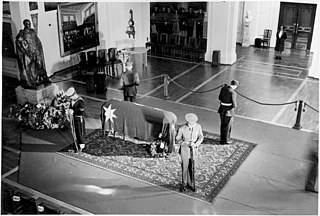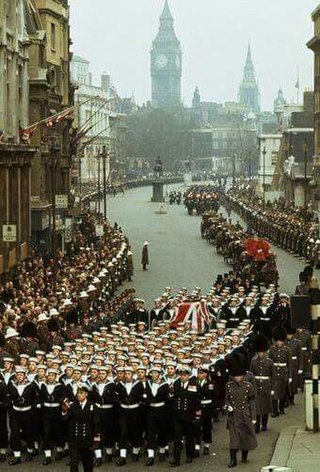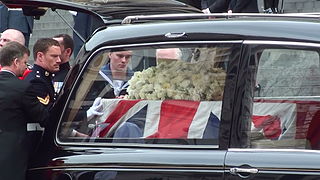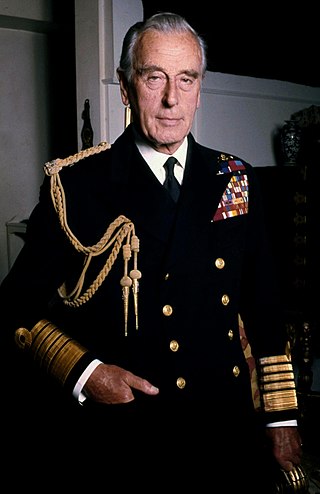The funeral directors to the Royal Household of the Sovereign of the United Kingdom are selected and appointed by the Lord Chamberlain's Office.
Contents





The funeral directors to the Royal Household of the Sovereign of the United Kingdom are selected and appointed by the Lord Chamberlain's Office.





Usually privately owned and commercially operated businesses, the funeral directors to the Royal Household do not have more than an occasional role, although they will be called upon if a death occurs in the Royal Family to assist in the funeral arrangements.
The same companies are normally used to assist during state or ceremonial funerals of eminent people outside the Royal Family, for example Sir Winston Churchill or Margaret Thatcher.
Although comparable in their role and function to Royal Warrant holders, the funeral directors serving the Royal Household do not traditionally advertise the fact that they work for the Royal Family.
It is not known when the Royal Household of the Sovereign of the United Kingdom began to employ privately owned and commercially operated funeral directors' companies. In the early 19th century, the royal undertakers were the family business of William Banting of St. James’s Street, London. The Banting family conducted the funerals of King George III in 1820, King George IV in 1830, Prince William Frederick, Duke of Gloucester and Edinburgh in 1834, Arthur Wellesley, 1st Duke of Wellington in 1852, Prince Albert in 1861, Prince Leopold in 1884, Queen Victoria in 1901, and King Edward VII in 1910. The royal undertaking warrant for the Banting family ended in 1928 with the retirement of William Westport Banting. [1]
After the Banting family had ceased to operate as royal funeral directors in 1928, several society undertaking firms lobbied for the warrant. It was finally awarded to the socially and politically well-connected Sir Harold Vaughan Kenyon, who also served six terms as Mayor of Paddington. [2] His company had been established in 1880 by his father, James Harold Kenyon (1841-91) and was incorporated under the name of J. H. Kenyon Ltd in 1899. It was this company which oversaw the funerals of George VI in 1952, Queen Mary in 1953, and Sir Winston Churchill in 1965. [3] The company's chief embalmer during this period was Desmond Henley. Another London firm, William Garstin, not J H Kenyon, assisted with the funeral arrangements for King George V. [4]
In 1991, the royal undertaking warrant passed to Leverton & Sons , a 200-year-old family owned and operated firm of funeral directors. [5] Leverton & Sons was established in St Pancras in 1763 by Devonshire carpenter John Leverton. In 1888, the business moved to Eversholt Street in Camden, north London, where its headquarters remain. [6] In 2007 company director Clive Leverton explained the mode of appointment to The Daily Telegraph . "'There is no written contract,' he said. 'It is just a handshake really.'" [5]
In 1997 Leverton & Sons assisted with the repatriation of the body of Diana, Princess of Wales. The company also organised the funerals of Queen Elizabeth The Queen Mother in 2002, Princess Margaret in 2002, Baroness Thatcher in 2013, [6] Prince Philip, Duke of Edinburgh in 2021 [7] and Queen Elizabeth II in 2022, where they were assisted in Scotland by William Purves Funeral Directors of Edinburgh. [8]
Master of the King's Music is a post in the Royal Household of the United Kingdom. The holder of the post originally served the monarch of England, directing the court orchestra and composing or commissioning music as required.

William Banting was a notable English undertaker. Formerly obese, he is also known for being the first to popularise a weight loss diet based on limiting the intake of carbohydrates, especially those of a starchy or sugary nature. He undertook his dietary changes at the suggestion of Soho Square physician William Harvey, who in turn had learned of this type of diet, but in the context of diabetes management, from attending lectures in Paris by Claude Bernard.

A state funeral is a public funeral ceremony, observing the strict rules of protocol, held to honour people of national significance. State funerals usually include much pomp and ceremony as well as religious overtones and distinctive elements of military tradition. Generally, state funerals are held in order to involve the general public in a national day of mourning after the family of the deceased gives consent. A state funeral will often generate mass publicity from both national and global media outlets.
Sir John Rupert Colville, CB, CVO was a British civil servant. He is best known for his diaries, which provide an intimate view of number 10 Downing Street during the wartime Premiership of Winston Churchill.
The Pilgrims Society, founded on 16 July 1902 by Sir Harry Brittain KBE CMG, is a British-American society established, in the words of American diplomat Joseph Choate, 'to promote good-will, good-fellowship, and everlasting peace between the United States and Great Britain'. It is not to be confused with the Pilgrim Society of Plymouth, Massachusetts.

Havengore is a former hydrographic survey launch, originally launched in 1956 for service with the Port of London Authority (PLA). After her withdrawal from service and sale in 1995, she was re-registered as a passenger vessel for up to 40 passengers. Based on the River Thames, Havengore has also served as a ceremonial vessel. She is best known for carrying the body of Sir Winston Churchill as part of his state funeral in 1965.

Winston Churchill Memorial Trusts (WCMT) are three independent but related living memorials to Sir Winston Churchill, based in the United Kingdom, Australia, and New Zealand. They exist for the purpose of administering Churchill Fellowships, also known as Churchill Travelling Fellowships, to provide an opportunity for applicants to travel overseas to conduct research in their chosen fields.

The funeral of Diana, Princess of Wales, started on Saturday 6 September 1997 at 9:08 am in London, when the tenor bell of Westminster Abbey started tolling to signal the departure of the cortège from Kensington Palace. The coffin was carried from the palace on a gun carriage by riders of the King's Troop and escorted by mounted police along Hyde Park to St James's Palace, where Diana's body had remained for five days before being taken to Kensington Palace. The Union Flag on top of the palace was lowered to half mast. The official ceremony was held at Westminster Abbey in London and finished at the resting place in Althorp.

Edward VII, King of the United Kingdom of Great Britain and Ireland and Emperor of India, died on Friday 6 May 1910 at the age of 68. His state funeral occurred two weeks later, on 20 May 1910. He was succeeded by his only living son, George V.
Blanche Milborne, Lady Herbert of Troy was the Lady Mistress in charge of the upbringing of Queen Elizabeth I, Edward VI and also of Queen Mary when she lived with the younger Tudor children. She was twice married, and widowed; first to James Whitney, then to Sir William Herbert of Troy Parva, an illegitimate son of William Herbert, 1st Earl of Pembroke and one of his mistresses. She had five children. Blanche Milborne died c. 1557 before Queen Elizabeth I's accession.

In the United Kingdom, state funerals are usually reserved for monarchs. The most recent was the state funeral of Queen Elizabeth II on 19 September 2022.

William France Jr. was a cabinetmaker and upholsterer in 18th century London and a member of the well known France family who held the Royal Warrant for over half a century. He was the nephew of William France Sr. and younger brother of Edward France, the former being cabinetmaker to the Royal Household. He was born in 1759 and died in 1838 in Boulogne, France. He was made a Freeman of Lancaster in 1785–86.

Royal warrants of appointment have been issued since the 15th century to those who supply goods or services to a royal court or certain royal personages. The warrant enables the supplier to advertise the fact that they supply to the royal family, thereby lending prestige to the brand or supplier. In the United Kingdom, grants are usually made by the monarch, spouse, and heir apparent to companies or tradespeople who supply goods and services to individuals in the family.
Desmond Charles Henley, OBE was an English embalmer.

Operation Hope Not was the code name of the plan for the state funeral of Sir Winston Churchill. It was titled The State Funeral of The Right Honourable Sir Winston Leonard Spencer Churchill, K.G., O.M., C.H., and was begun in 1953, twelve years before his death. The detailed plan was prepared in 1958. Churchill led the country to victory in the Second World War (1939–1945) during his first term as Prime Minister of the United Kingdom. While in his second term he was struck by a major stroke in 1953 that caused concern for his health. The British Government started a meticulous preparation, as officially decreed by Queen Elizabeth II, to be of a commemoration "on a scale befitting his position in history". As remarked by Lord Mountbatten, Churchill "kept living and the pallbearers kept dying" such that the plan had to be revised several times in the years before his death in 1965.

Sir Winston Churchill, the British statesman, soldier, and writer who served as Prime Minister of the United Kingdom during the Second World War, died on 24 January 1965, aged 90. His was the first state funeral in the United Kingdom for a non-member of the royal family since Edward Carson's in 1935. It was the last state funeral until Queen Elizabeth II's on 19 September 2022. The official funeral lasted for four days. Planning for the funeral, known as Operation Hope Not, began after Churchill's stroke in 1953 while in his second term as prime minister. After several revisions due to Churchill's continued survival, the plan was issued on 26 January 1965, two days after his death.

On 6 February 1952, George VI, King of the United Kingdom, died at the age of 56, at Sandringham House, after a prolonged cancer. His state funeral took place on 15 February 1952. A period of national mourning commenced and his elder daughter and successor, Queen Elizabeth II, was proclaimed the new monarch by the Accession Council. George VI's coffin lay in St Mary Magdalene Church, Sandringham until 11 February when it was carried, in procession, to the nearby Wolferton railway station. The coffin was carried by train to London King's Cross railway station where another formal procession carried it to Westminster Hall where the king lay in state for three days. Some 304,000 people passed through Westminster Hall with queues up to 4 miles (6.4 km) forming.

Leverton & Sons Ltd is an independent family-run firm of funeral directors in Camden, London and the current funeral directors to the Royal Household. Established in 1789, the firm has been based in Camden for more than 200 years. Leverton & Sons arrange around 1,000 funerals a year and past funerals have included those of George Orwell, Kenneth Williams, Michael Foot, Margaret Thatcher and Queen Elizabeth II.

The ceremonial funeral of Admiral of the Fleet The 1st Earl Mountbatten of Burma took place on Wednesday, 5 September 1979, at Westminster Abbey following his assassination by the Provisional Irish Republican Army on Monday, 27 August 1979, off the coast of the Mullaghmore Peninsula in County Sligo, Ireland.